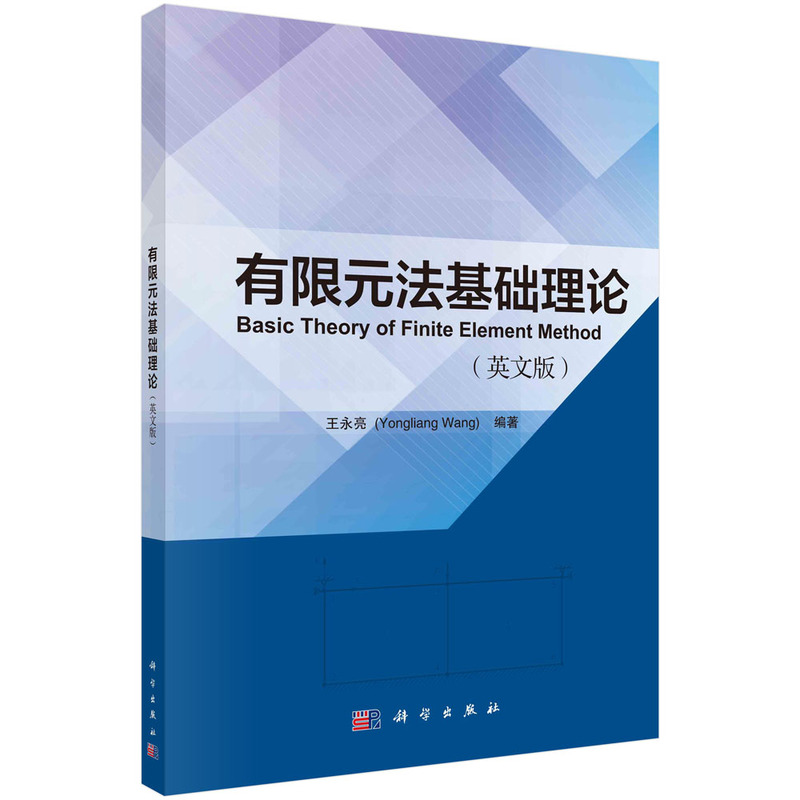
Basic Theory of Finite Element Method
1星价
¥65.6
(8.3折)
2星价¥65.6
定价¥79.0

暂无评论
图文详情
- ISBN:9787030752918
- 装帧:平装-胶订
- 册数:暂无
- 重量:暂无
- 开本:其他
- 页数:184
- 出版时间:2023-04-01
- 条形码:9787030752918 ; 978-7-03-075291-8
内容简介
从改革教学方式和丰富课程体系的角度考虑,本书在编写过程中遵守以下四方面内容要求:(1)英文内容:全书内容以英文为主,采用简单、常见的英语词汇,辅助关键专业词汇的中文释义,降低全英文或中英双语课程教学在专业英语、专业理论上的“双重”挑战。(2)系统知识:书中内容仅要求读者具备弹性力学基本知识,以简单的一维弹性问题弱形式和有限元求解方法入手,深入介绍二维、三维的弹性力学问题的单元、等参变换、数值积分、求解格式等基本概念和关键技术,使读者快速建立有限元法的知识体系。(3)编程实践:掌握有限元法的基础理论、并具备一定的编程能力是当前计算力学学习的基本要求。本书结合理论知识,给出有限元法的典型应用程序,便于读者借鉴编程操作。书中程序电子文件可在以下网站下载:http://www.wangyongliang.net/programsofFEM.htm。(4)高等用法:书中简要介绍有限元解答的误差估计和自适应方法,使读者了解有限元法高性能计算和分析技术,供有更高学习需求的读者参考。
目录
Contents
Chapter 1 Introduction of Finite Element Method 1
1.1 Development Process of Finite Element Method 1
1.2 Computation Procedure of Finite Element Method 3
1.3 Main Contents of the Book 4
1.4 Exercises 5
Chapter 2 Fundamentals of Elasticity Mechanics 6
2.1 Displacements 7
2.2 Strains 8
2.3 Stresses 8
2.4 Geometric Equations 9
2.5 Constitutive Equations 10
2.6 Equilibrium Equations 12
2.6.1 Three-Dimensional Problems 12
2.6.2 Two-Dimensional Plane Stress and Strain Problems 13
2.6.3 Two-Dimensional Axisymmetric Problems 13
2.7 Boundary Conditions 13
2.8 Exercises 14
Chapter 3 Weak Form of Equivalent Integration 15
3.1 Weak Form of Equivalent Integration for Differential Equations 15
3.2 Weak Form of One-Dimensional Elasticity Problems 15
3.3 Finite Element Computation Based on Weak Form 17
3.3.1 Galerkin Method 17
3.3.2 Finite Element Computation 20
3.4 Global Assembly from One-Dimensional Elements 23
3.5 Treatments on Boundary Conditions 24
3.6 Exercises 28
Chapter 4 Elements and Shape Functions 29
4.1 One-Dimensional Lagrange Element 29
4.1.1 Linear Element with Two Nodes 29
4.1.2 Higher-Order Lagrange Element 29
4.1.3 Quadratic Lagrange Element 31
4.2 Two-Dimensional Triangle Element 32
4.2.1 Triangle with Three Nodes 32
4.2.2 Higher-Order Triangle Element 35
4.2.3 Quadratic Triangle Element 37
4.2.4 Cubic Triangle Element 37
4.3 Two-Dimensional Rectangle Element 37
4.3.1 Linear Rectangle Element with Four Nodes 37
4.3.2 Higher-Order Rectangle Element 39
4.3.3 Quadratic Rectangle Element 40
4.4 Three-Dimensional Tetrahedron Element 41
4.4.1 Linear Tetrahedron Element with Four Nodes 41
4.4.2 Higher-Order Tetrahedron Element 44
4.4.3 Quadratic Tetrahedron Element 44
4.4.4 Cubic Tetrahedron Element 44
4.5 Three-Dimensional Hexahedron Element 45
4.5.1 Hexahedron with Eight Nodes 45
4.5.2 Higher-Order Hexahedron Element 46
4.5.3 Quadratic Hexahedron Element 47
4.6 Exercises 48
Chapter 5 Isoparametric Element and Numerical Integration 50
5.1 Isoparametric Element 50
5.1.1 One-Dimensional Isoparametric Lagrange Element 50
5.1.2 Two-Dimensional Isoparametric Triangle Element 51
5.1.3 Two-Dimensional Isoparametric Rectangle Element 53
5.1.4 Three-Dimensional Isoparametric Tetrahedron Element 54
5.1.5 Three-Dimensional Isoparametric Hexahedron Element 56
5.1.6 Requirements of Isoparametric Element 58
5.2 Numerical Integration 59
5.2.1 One-Dimensional Integration for Lagrange Element 59
5.2.2 Two-Dimensional Integration for Triangle Element 62
5.2.3 Two-Dimensional Integration for Rectangle Element 63
5.2.4 Three-Dimensional Integration for Tetrahedron Element 64
5.2.5 Three-Dimensional Integration for Hexahedron Element 65
5.2.6 Required Order of Numerical Integration 66
5.3 Exercises 67
Chapter 6 Finite Element Computation Scheme of Elasticity Problems 68
6.1 Weak Form for General Elasticity Problems 68
6.2 Finite Element Method for Solving Elasticity Problems 71
6.3 Global Assembly from High-Dimensional Elements 72
6.4 Treatments on Boundary Conditions 78
6.5 Exercises 82
Chapter 7 Solutions of Linear Algebraic Equations 83
7.1 LU Decomposition Method 83
7.2 Exercises 87
Chapter 8 Error Estimation and Adaptive Analysis 88
8.1 Error Estimation of Finite Element Solutions 88
8.1.1 Error of Finite Element Solutions 88
8.1.2 Superconvergent Patch Recovery Method 88
8.2 Adaptive Finite Element Method 90
8.2.1 Categories of Adaptive Finite Element Method 90
8.2.2 h-Version Adaptive Finite Element Method 91
8.2.3 hp-Version Adaptive Finite Element Method 92
8.3 Exercises 94
Chapter 9 Programs of Finite Element Method 95
9.1 One-Dimensional Program of Beam Deformation 95
9.1.1 Main Program 96
9.1.2 Numerical Example 98
9.1.3 Interactive Interface 98
9.2 Two-Dimensional Program of Plane Strain Problem 108
9.2.1 Main Program 108
9.2.2 Numerical Example 112
9.2.3 Interactive Interface 114
9.3 Three-Dimensional Program of Solid Compression 124
9.3.1 Main Program 124
9.3.2 Numerical Example 128
9.3.3 Interactive Interface 131
9.4 Exercises 141
Appendix A. Keyword Index 143
Appendix B. Matrix Calculation 145
B.1 Definition 145
B.2 Matrix Addition or Subtraction 146
B.3 Transpose 146
B.4 Transpose of a Product 147
B.5 Inverse 147
B.6 Symmetric Matrices 148
B.7 Partitioning 148
Appendix C. Summary of Elements and Shape Functions 150
C.1 One-Dimensional Lagrange Element 150
C.2 Two-Dimensional Triangle Element 150
C.3 Two-Dimensional Rectangle Element 151
C.4 Three-Dimensional Tetrahedron Element 151
C.5 Three-Dimensional Hexahedron Element 152
Appendix D. Gaussian Integration Points and Weights 154
Appendix E. Exercise Solutions 158
References 174
展开全部
本类五星书
本类畅销
-

当代中国政府与政治(新编21世纪公共管理系列教材)
¥33.6¥48.0 -

落洼物语
¥8.7¥28.0 -

中国当代文学名篇选读
¥19.1¥53.0 -

中医基础理论
¥50.7¥59.0 -

北大人文课(平装)
¥13.9¥45.0 -

外国教育史-第2版
¥24.4¥40.0 -

宪法-第二版
¥12.2¥29.0 -

当代中国政府与政治 第二版
¥57.8¥68.0 -

EPLAN电气设计
¥29.9¥39.8 -

闯进数学世界――探秘历史名题
¥21.3¥32.8 -

企业法务教程
¥34.8¥49.0 -

习近平新时代中国特色社会主义思想概论
¥18.2¥26.0 -

金融学
¥29.9¥49.0 -

计算机操作系统教程(第4版)(清华大学计算机系列教材)
¥31.9¥49.0 -

三国史
¥27.5¥50.0 -

飞机总体设计
¥46.8¥78.0 -

古代汉语(第四册)
¥16.1¥35.0 -

编辑审稿实务教程
¥35.1¥45.0 -

管理学:原理与方法(第7版)(博学.大学管理类)/周三多
¥30.9¥49.0 -

(平装)北大必修课:北大口才课
¥12.2¥45.0











